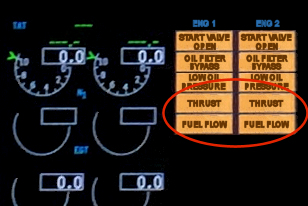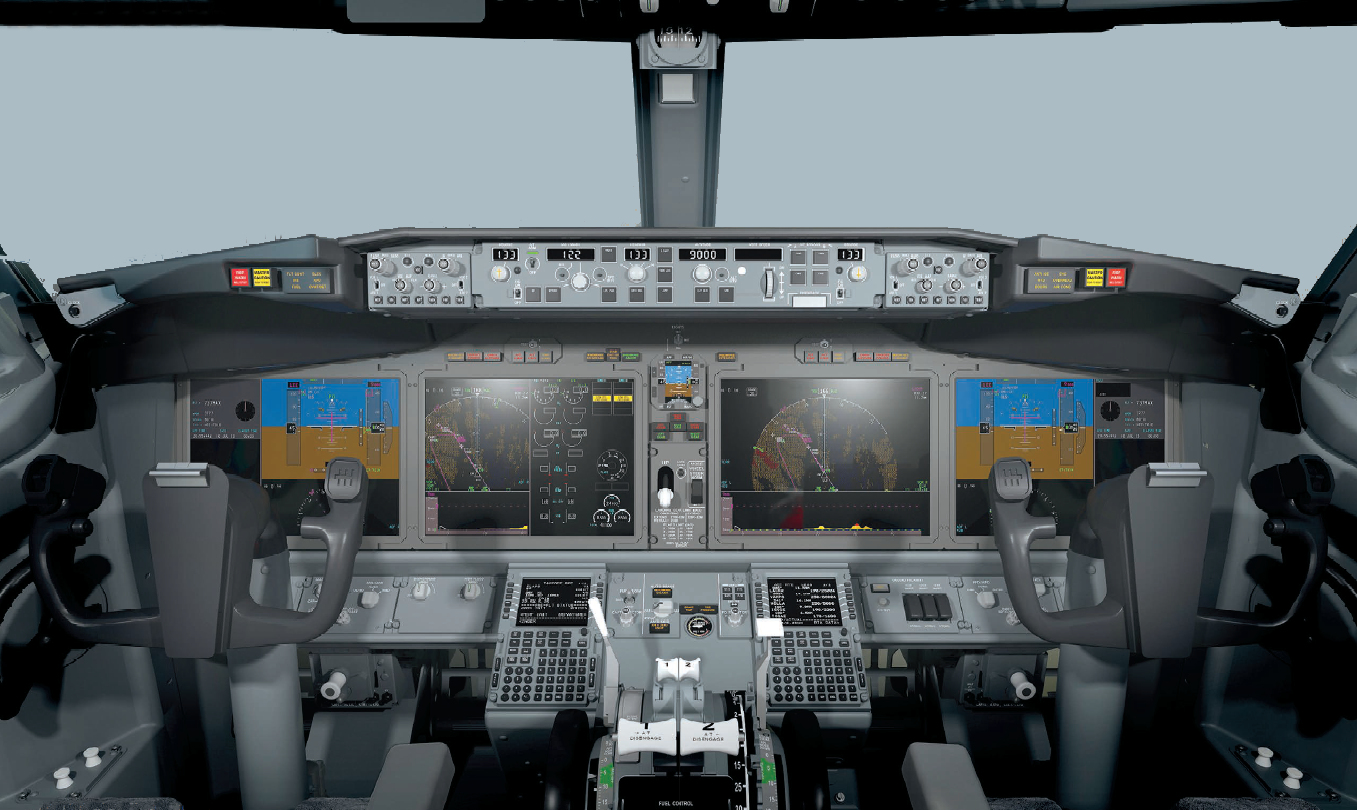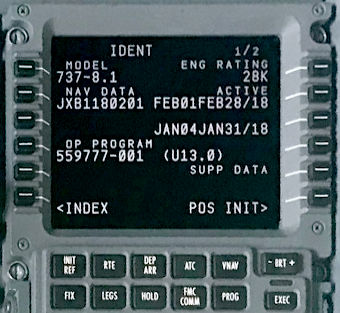New Features
Boeing will certify the Max series under an amended type certificate as part of the 737 family rather than go for a whole new type certificate.
New features:
Differences
Weight
The MAX is approximately 3,000kg heavier than its equivalent NG. This all stems from the LEAP1B engines each of which are 385kg heavier than the CFM56-7. This extra weight requires stronger (and therefore heavier) engine struts, wings, fuselage and landing gear. The upside of this strengthening is that operating weights (MTOW, MZFW etc) have been increased by 3,175kg to compensate.
Handling
The thrust line has changed from the NG because the engines had to be moved forward and up to accomodate the larger fan diameter. Any handling differences as a result of this have been tuned out by Boeing in the flight control system to make the types feel the same to crew. This was necessary for certification under the same type certificate.
Pneumatics
The pneumatic bleed air system now has an electronic controller. This allows the aircraft to digitally tune the amount of air that is needed in whatever flight regime you’re in. This is different to the previous "all or nothing" system which would often take more bleed air from the engines than necessary thereby reducing performance.
BLEED TRIP OFF lights on pneumatic panel are replaced by BLEED. This is to indicate that either a bleed has tripped off due to excessive bleed air temperature, pressure or under-pressure, OR there is a failure in the bleed air system OR that there is an incorrect bleed config after take-off or go-around.
One of the faults detected by the system is an underpressure. If the duct pressure drops below 13psi with engines running, the controller closes the suspect valve to protect the affected system.
Note that the system conducts a series of self tests after landing known as Post-Flight Built In Tests (PFBIT). This is a controller initiated, non-interactive test sequence that checks the capability of the PRSOV solenoid to close the valve, independent of the torque motor. These can be observed as duct pressure splits and are normal on the MAX.
Anti-Ice & Rain
The engine anti-ice panel has a new amber caption ENGINE ANTI-ICE. When illuminated this indicates that the engine cowl thermal anti-ice system has been inhibited due to a system failure or when an engine core anti-ice valve fails closed.
Electrics
Essentially the same as the NG, however on the MAX, the ground crew call horn will sound a continuous tone 2 minutes after a battery discharge condition is detected.
Powerplant
The MAX has a CFM LEAP-1B fan with a 69.4 inch fan diameter. It will have a 11-12% reduction in fuel burn and 7% reduction in operating cost compared to the NG. The nacelle and pylon will cause the engines to project further forward than the CFM56-7BE on 737NG.
There is a new Ground wind operating envelope found in Aircraft General Operating Limitations:
- For crosswinds greater than 43 knots, limit thrust to a setting normally used for taxi.
- Except when setting takeoff thrust on the runway, limit engine thrust to idle for winds greater than 58 knots.
There are two new crew alerts on the inboard DU of THRUST and FUEL FLOW

In simple terms THRUST will illuminate if the actual thrust is more or less than the commanded thrust and FUEL FLOW will illuminate if the actual fuel flow is abnormally high compared to the FMC expected fuel flow.
Note that the entire block will blink for 10 seconds then remain steady amber for as long as the condition exists.
Engine starting
The LEAP-1B engine start sequence is slightly different to the old CFM-56. After the engine start switch is moved to GND, the EEC performs Bowed Rotor Motoring (BRM). This is to straighten the N1 and N2 shafts which may have bowed due to thermal buildup after the previous shutdown. BRM will be active from 6 to 90 seconds and MOTORING will be displayed on the N2 gauge between 18-24%.
At 25% N2 or max motoring when you move the start lever to idle the EEC then performs a test of the Thrust Control Malfunction Accommodation (TCMA) and Electronic Overspeed System (EOS) functions. This manifests itself as the fuel flow indicating zero, the engine fuel shut off valve opening and closing repeatedly and the ENG VALVE CLOSED light illuminating bright blue until the test has finished whereupon the start sequence continues.
It certainly takes longer to start the engine on a MAX than an NG

Engine Panel
The MAX engline panel, located on the aft overhead panel, has now got three new amber caution lights to replace the old REVERSER amber caution lights.
For more details of the new MAX engine panel click here

APU
The MAX APU is still a Honeywell 131-9[B] but is updated to series 41 which has various minor improvements such as improved starting reliability.
Externally, the tailcone has been extended 43 inches for streamlining, this has enabled the aft body vortex generators to be removed and gives an overall reduction in fuel burn of 1%. The eductor inlet has moved to the right side of the tailcone and the air inlet door has been redesigned with the removal of the NACA duct and vortex generator. The inlet door is hinged at the aft end and opens outward into the airstream, it has three positions: Closed, Ground position (45deg) and Flight position (17deg). Normal door transitions take 40 to 120 seconds between positions. You can despatch with the door locked in the flight position at a 1% fuel burn penalty.

737 MAX APU air inlet closed

737 MAX APU air inlet open
The APU fire bottle contains HALON and Nitrogen. There is a customer option for an automatic APU fire extinguisher discharge whereby the APU fire extinguisher will discharge automatically 10 seconds after an APU fire warning is detected on the ground when main engines are not operating.
The EGT gauge has been removed from the APU panel on the overhead panel and the blue MAINT light has been changed to an amber DOOR light. Illumination of the DOOR light simply means that the door did not reach the commanded position within 165 seconds. The APU can continue to be used but some buffeting may be experienced and a fuel burn penalty of 2.4% should be applied.

There are three new status messages to replace the MAINT light as follows:
- APU GENERATOR - Means that the APU Generator has a shorted rotating diode
- APU OIL QTY - The oil quantity is low but there is sufficient oil for 30 to 50 hours of operation at the maximum oil consumption rate before a low oil pressure shutdown occurs.
- APU DOOR - The APU inlet door did not reached commanded position in 165 seconds. The DOOR light will also illuminate.
Flightdeck
The big difference is the 4 new 15.1 inch displays. In the central 4 inch gap between display 3 & 4 has been squeezed a smaller gear lever along with a lock override button, nosewheel steering selector, gear indication lights and placard speeds. The ISFD is above the gear panel. The flap position indicator is now part of the electronic displays. The autobrake and MFD selectors and brake pressure gauge have moved down to in between the FMCs. The PFD/MFD transfer switches are on the lighting panels in front of the control column. Even the clock has been integrated into the DUs.

The EFIS control panel now has a +/- range selector. VSD is selected from the centre button.
For a full list of MAX flightdeck differences with photos click here


Fuel
There are 4 new FMC driven crew alerts on the Engine Display:
FUEL DISAGREE - Displays if FQIS (totalizer) and FMC calculated fuel totals differ by more than 2000lbs, for more than 5 continuous minutes.
USING RSV FUEL - Logic changed to display if total fuel minus reserves entered is less than predicted fuel burn at destination.
INSUFFICIENT FUEL - Same logic but can now chaeck against execution of a mod flight plan.
FUEL FLOW 1/2 - FUEL FLOW (engine #) is displayed on the Engine Display if the engine fuel flow exceeds the FMC expected [based on aero performance Engine Performance Monitor (EPM) logic, and supporting MEDB data] by a 15%, for more than 5 continuous minutes.

Maximum fuel capacity very slightly less than NG due to wing strengthening. Capacities: 3,869 + 12,990 + 3,869 = 20,729kg
Landing Gear
Nose gear strut is 8 in. longer.
The MAX landing gear handle is a two-position handle (UP/DOWN). The center “OFF” position that removed hydraulic pressure from the actuators has been removed as the depressurization function is automated through a proximity switch system.
Navigation
FMC Update 13 was designed for the MAX and has been used as 13.0 on the test fleet. U13 software brings the baseline of U11 and U12 to the 737MAX and does not include any new functionality for the 737NG.
A few things unique to the MAX:
Percent De-rates & Variable Takeoff Ratings:
The 737-8 airframe allows selection of Percentage Takeoff Derates on the N1 LIMITS page based on existing function of Fixed Derates.
Engine Logic – EPM/TRM & Takeoff Speeds
New Engine Performance Model (EPM) and Thrust Rating Model (TRM) is required for 737-8.
Displays- Data output on Ethernet to MDS
The 737-8 includes large format display to the 737 flight deck.

For more details of the FMC Update 13 click here
Flight Control Computer
Cross FCC monitor added. Details here
Flight Controls
FBW Spoiler System
The MAX has a new fly-by-wire spoiler system. This is officially to improve production flow, reduce weight and improve stopping distances.The spoiler mixer unit has been replaced by a Spoiler Control Electronics (SCE) unit and the ground spoiler control valve is replaced by a Ground Spoiler Control Module (GSCM).
Here are some of the new features that system brings.
For more details of the MAX FBW Spoiler system click here

Maneuvering Characteristics Augmentation System (MCAS)
MCAS (Maneuvering Characteristics Augmentation System) is implemented on the 737 MAX to enhance pitch characteristics with flaps UP and at elevated angles of attack. The MCAS function commands nose down stabilizer to enhance pitch characteristics during steep turns with elevated load factors and during flaps up flight at airspeeds approaching stall. MCAS is activated without pilot input and only operates in manual, flaps up flight. The system is designed to allow the flight crew to use column trim switch or stabilizer aisle stand cutout switches to override MCAS input. The function is commanded by the Flight Control computer using input data from sensors and other airplane systems.
The MCAS function becomes active when the airplane Angle of Attack exceeds a threshold based on airspeed and altitude. Stabilizer incremental commands are limited to 2.5 degrees and are provided at a rate of 0.27 degrees per second. The magnitude of the stabilizer input is lower at high Mach number and greater at low Mach numbers. The function is reset once angle of attack falls below the Angle of Attack threshold or if manual stabilizer commands are provided by the flight crew. If the original elevated AOA condition persists, the MCAS function commands another incremental stabilizer nose down command according to current aircraft Mach number at actuation.
For a full description of MCAS see this video:
Stab Trim Switches
MAIN ELEC and AUTO PILOT Stab trim switches now either switch will cut-off both main electric and autopilot stab trim. They are renamed PRI and B/U (primary and backup). The switches are guarded in the NORMAL position (switch up) and CUTOFF is switch down.

Third AoA Source
Patrick Ky, executive director of the European Union Aviation Safety Agency (EASA) said in Sep 2020 that Boeing has agreed to install a "computerized third-sensor system" on the 737 MAX 10, followed by retrofits on the rest of the MAX fleet later.
Warning Systems
The PSEU light has been changed to MAINT. Its function is similar to the PSEU light.
More details here
Onboard Maintenance System
The Onboard Network System (ONS) monitors the aircraft systems hardware and software for faults and health monitoring and sends alerts to pilots and maintenance staff via the enhanced digital flight data acquisition unit (eDFDAU). It can store over 75 flight hours of data and analyse and trend that data in-flight on its data file server.
Its big advantage over previous systems is that it collects and sends data from all monitored systems for viewing by pilots or maint crews either on the flightdeck display systems and/or at maintenance base, rather than maintenance crews having to locate and interrogate or BITE check each individual system component many of which were located in the E&E bay.

The ONS and MAX display system integrate airplane data collected during flight with a new Onboard Maintenance Function (OMF) that consolidates maintenance data for view on the flight deck displays and on portable maintenance devices, such as tablets (there is an iPad app called Boeing ONS Maintenance that anybody can download from iTunes). OMF began with more than 1,700 requirements from Boeing and took two and a half years to develop, programmed in just 32,000 lines of Clojure code. The OMF can report over 6000 error codes but it also takes specific conditions and sequences, combines rules and events, manages dependencies, and aggregates fault conditions.
The Onboard Maintenance Function can be seen on the inboard halves of the Inboard Display Units by using the Engine Display Control Panel Selectors (located near the autobrake selector).
For more details on the ONS and maintenance pages follow this link.
Variants
The following MAX variants are being offered:
-7
A slightly shorter, longer range version of the -8 but longer than the 737-700. Overall length 33.7m, Max capacity 172 passengers hence two pairs of overwing exits, Range approx 3825nm. Expected certification date late 2022. See here for more details.
-8
The baseline MAX, equivalent of the 737-800. Entered service May 2017.
-9
Stretched version of the -8. Similar to the -900ER. Entered service March 2018. See here for more details
-10
A stretched MAX-9 due to slow sales against the A321NEO. See here for more details. Expected certification date 2023
-8200
This is a 200 seat version of the MAX 8 which has an extra pair of Type II doors aft of the wing (as in the 900ER and MAX 9) giving it a maximum certified passenger capacity of 200. The seat pitch will remain at 30 inches with space being gained by slimline seats and removing space from front and rear galleys. The Max 8200 FF 13 Jan 2019, Certified 31 Mar 2021, First delivery 16 Jun 2021
BBJ
The 737 MAX is also being offered as a BBJ. The BBJ 2 MAX, based upon the MAX 8, will have a potential range of 6,325nm.
|
 Boeing 737 MAX - Differences
Boeing 737 MAX - Differences